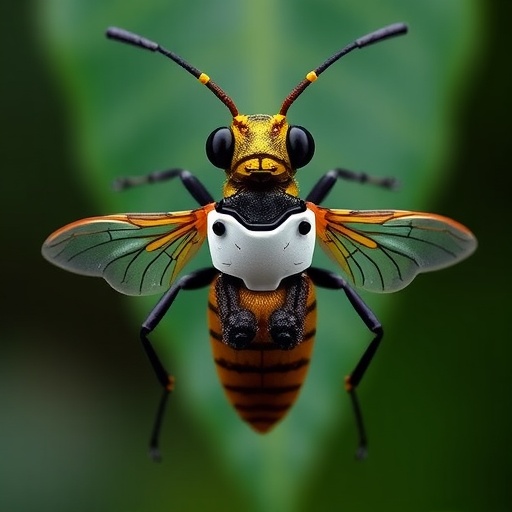In a groundbreaking advancement poised to redefine the field of biohybrid robotics, researchers at Nanyang Technological University have unveiled a sophisticated, noninvasive wearable system designed for cyborg insects. This innovative technology circumvents the long-standing challenges associated with traditional cyborg insect methodologies, which often involve irreversible sensory damage or complex adhesive applications, by harnessing precision 3D printing and novel mechanical design principles to interface seamlessly with the insect’s own anatomy.
Historically, the integration of electronic components with live insects required invasive procedures such as cutting antennae or cerci to embed electrodes. These manipulations, while effective in transmitting stimuli, irreparably damage the insect’s sensory apparatus, impairing its ability to navigate and perceive environmental cues. Alternative approaches involving adhesive films present their own set of drawbacks, including durability issues, exoskeleton damage upon removal, and extensive preparation protocols that hinder scalability and ethical compliance. Recognizing these limitations, the NTU team engineered a wearable solution that adheres securely without adhesives or tissue damage, preserving the cockroach’s native sensory functions.
Central to this innovation is the design of two ergonomic devices: a head-mounted unit targeting antennae stimulation and an abdominal buckle for motion modulation. The headgear’s architecture leverages a 3D model of the cockroach’s head to tailor-fit the device, optimizing attachment without compromising mobility or vital sensory organs. A key feature is the incorporation of C-shaped elastic connectors engineered to envelop the scape, the robust proximal segment of the antenna, allowing stable electrical stimulation to be conducted without penetrating delicate structures housing sensory receptors. Complementing this is a triangular hooking mechanism comprising three strategically placed hooks that anchor on the hard exoskeleton of the head capsule, thereby avoiding sensitive regions such as the compound eyes and mouthparts, and enabling the insect to feed unhindered.
The abdominal component embodies an equally refined design philosophy anchored in biomechanics. Rather than relying on friction or adhesives, it utilizes a combination of a U-shaped clamp and gripping hooks that latch onto the edges of the second and sixth abdominal terga—rigid exoskeletal plates characterized by overlapping segments. This configuration exploits these natural overlaps to foster remarkable stability, accommodating abdominal flexion and extension during locomotion while preventing slippage. Such attentiveness to the cockroach’s morphology ensures consistent device placement over extended operational periods.
Manufacturing these intricate devices demanded advanced techniques capable of producing multicomponent structures with distinct mechanical and electrical functionalities. The researchers employed digital light processing (DLP)-based multimaterial 3D printing, a high-resolution additive manufacturing method that permits simultaneous printing of materials with different properties. This approach facilitated the precise fabrication of normal resin elements alongside an active precursor resin designed for electroless copper plating, rendering surfaces conductive without compromising structural integrity. The result is a micromechanical system integrating conductive pathways seamlessly within a robust, lightweight framework.
Experimental validation was conducted using Madagascar hissing cockroaches (Gromphadorhina portentosa), a species favored for cyborg research owing to its substantial payload capacity and resilience. Key performance metrics included the stability of neural response signals under electrical stimulation, the precision of motion control protocols, and the insect’s ability to traverse complex, obstacle-laden environments. The findings demonstrated that the noninvasive wearable system reliably elicited targeted behavioral responses and maintained stable contact over repeated trials, indicative of superior mechanical and electrical stability compared to previous methods.
Beyond the immediate technical triumphs, this research marks a significant ethical advance in the realm of animal-integrated technologies. By eschewing invasive implantation and minimizing distress or injury, the approach aligns with the principles of Replacement, Reduction, and Refinement (3Rs) in humane animal research. This ethical compliance not only addresses societal concerns but also broadens the potential for regulatory acceptance in applications involving living biohybrid systems.
The implications of this technology extend well beyond the laboratory. By enabling precise sensory modulation and locomotor control without sensory deprivation or physical impairment, these cyborg insects may soon serve as scalable, versatile platforms for environmental monitoring, search and rescue operations, and other robotics applications that benefit from the mobility and sensory sophistication of living organisms. Moreover, the fusion of advanced manufacturing with bioengineering showcased here could inspire new paradigms for wearable interfaces in diverse biological systems.
Looking forward, the multidisciplinary team led by Professor Hirotaka Sato envisions expanding the application of their ergonomic wearable devices to other insect species and possibly integrating additional functionalities, such as biochemical sensing or wireless communication. By refining the scalability of their 3D printing and plating processes, they aim to facilitate widespread deployment of cyborg insect systems with minimized preparation times and enhanced durability.
Ultimately, this research signifies a leap toward the practical realization of biohybrid robots that synergize the best of biological sensing and robotic control. The careful preservation of natural sensory pathways combined with durable, user-friendly wearable technology heralds a new chapter in the development of living machines with real-world utility—a transformation from proof-of-concept experiments to functional, deployable tools reshaping robotics and synthetic biology landscapes.
Subject of Research: Noninvasive wearable devices for sensory stimulation and motion control in cyborg insects
Article Title: Ergonomic Insect Headgear and Abdominal Buckle with Surface Stimulators Manufactured via Multimaterial 3D Printing: Snap-and-Secure Installation of Noninvasive Sensory Stimulators for Cyborg Insects
News Publication Date: September 22, 2025
Web References: DOI: 10.34133/cbsystems.0406
Image Credits: Hirotaka Sato, School of Mechanical and Aerospace Engineering, Nanyang Technological University
Keywords: Applied sciences and engineering, Mathematics, Life sciences




